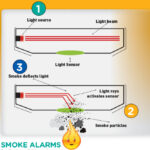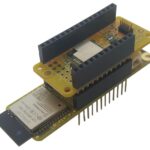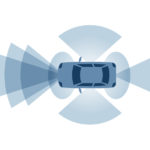The low-cost, reliable, ubiquitous smoke detector is an example of complex physics and optics made real by semiconductors.
Given the huge market for smoke alarms of both types—easily tens of millions of units per year for new and replacement/upgrade units—it’s no surprise that many IC vendors offer components and reference designs for this application. It is not a simple decision since any final designs must be approved by regulatory organizations such as Underwriter’s Laboratory (UL) or similar in the US and corresponding certification organizations in other regions and countries. Even the alarm horn pattern is defined by UL217, NFPA72, and ISO8201.
Still, it’s an attractive opportunity. Some vendors offer photoelectric and ionization devices, while others offer only one type. Among the vendors offering ICs for smoke alarms are Allegro Microsystems, Analog Devices, Microchip Technology, NXP Semiconductor (primarily via devices and product lines that came with their acquisition of Freescale in 2015), Renesas Electronics Corp., and Texas Instruments. Their ICs and related components have similarities but also have differences to distinguish them from their competition.
Q: What else must a basic smoke detector do?
A: Besides providing basic management of the LED emitter and photosensor, smoke detectors must also drive a “horn” (a piezoelectric sounder) and flash a visible LED indicator to the user. Some also can interface to a driver for a high-power strobe flasher for hearing-impaired users or settings, and many newer ones also have I/O to communicate with other units (more on this in Part 4). Finally, they must have self-test modes as well as user-initiated self-test mode (via a simple pushbutton) to ensure that the LED, photosensor, and other circuitry are still functional.
Q: What are the broad challenges component vendors face in addition to cost pressures?
A: Smoke detector manufacturers have multiple critical challenges:
- Developing higher-performance units reduces the frequency of false alarms, resulting in consumers disabling or turning off the units.
- Meeting existing and new regulatory requirements (UL217, UL268. EN54/14604).
- Minimizing power consumption to lengthen the time between battery replacement.
- Reducing detector size to enable easier architectural integration and aesthetic appeal.
- Incorporating a self-calibration scheme, since photonic devices (optical emitters and receivers) have wide unit-to-unit and lot-to-lot variations in performance. Self-calibration would simplify manufacturing and save cost and time in production.
Q: Can you give an example of a basic IC for the photoelectric application?
A: One basic smoke detector IC is the NXP (Freescale) MC145010, a 16-lead CMOS device (Figure 1). Its variable-gain photoamplifier allows direct interface to photodiodes functioning as IR detectors. While in standby, the low-supply detection circuitry conducts periodic checks using a pulsed load current from the LED pin. The trip point is set using two external resistors. The supply for the MC145010 can be a standard 9-V battery since it operates from a supply of 6 to 12 volts and with an average supply current of just 12 μA.
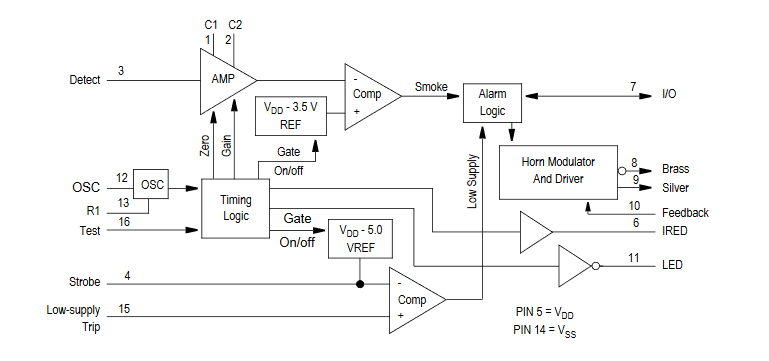
The requirements of the LED emitter, photosensor, and other functions mean that this IC also requires other passive components (Figure 2). For example, two external capacitors determine the gain settings. Low gain is selected by the IC during most of the standby state, medium gain is selected during a local-smoke condition, and high gain is used during a pushbutton-initiated test. During standby, the special monitor circuit periodically checks for degraded chamber sensitivity and uses high gain.
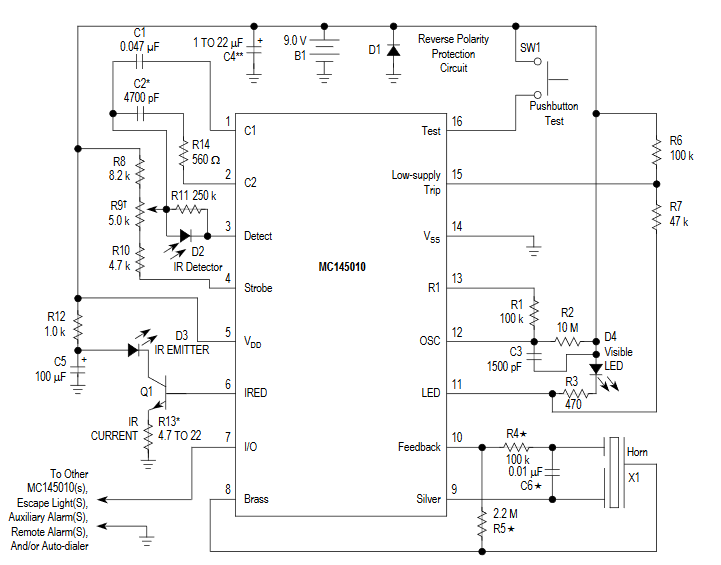
Q: What about other ICs?
A: A more advanced photoelectric smoke detector is the Renesas RAA239101 (Figure 3). The RAA239101 provides a driver that can switch between two LEDs to pulse the smoke detection LED emitters with a DAC-controlled adjustable current. Two photodiode receiver channels with programmable gain amplification using an ADC allow the detection of smoke by sensing the LED light scattered off any smoke in a detection chamber.
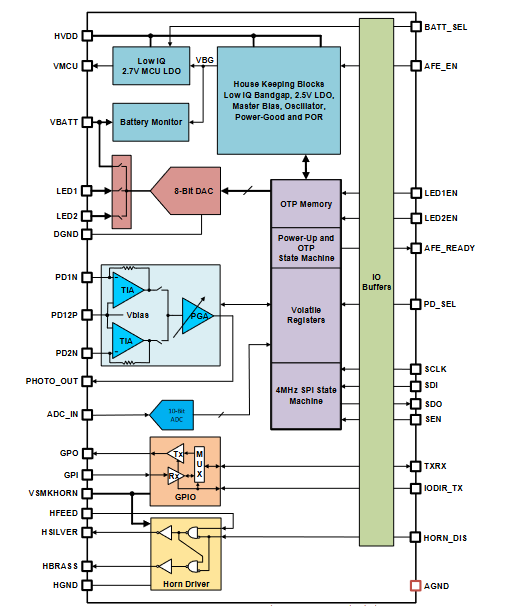
When combined with a microcontroller, photoelectric emitter/detector(s), horn, and external components, it forms a complete smoke detector (Figure 4). The IC operates from a 3 V to 5 V or from a 9-V battery and has an internal LDO to provide power to the microcontroller. The battery-check feature can signal an alarm when the battery is low.

Q: What about ionization-detector ICs?
A: Not surprisingly, they don’t appear to be very different than photoelectric ones. In both cases, the IC needs to detect the flow of current. The Allegro Microsystems A5367 is a low-current, BiCMOS circuit providing all of the required features for an ionization-type smoke detector (Figure 5). A wired networking capability allows as many as 125 units to be interconnected, so if any unit senses smoke, all units will also sound their alarms. In addition, special features are incorporated to facilitate alignment and testing of the finished smoke detector. Underwriters Laboratories recognize the device for use in smoke alarms that comply with Standard UL217 or UL268.
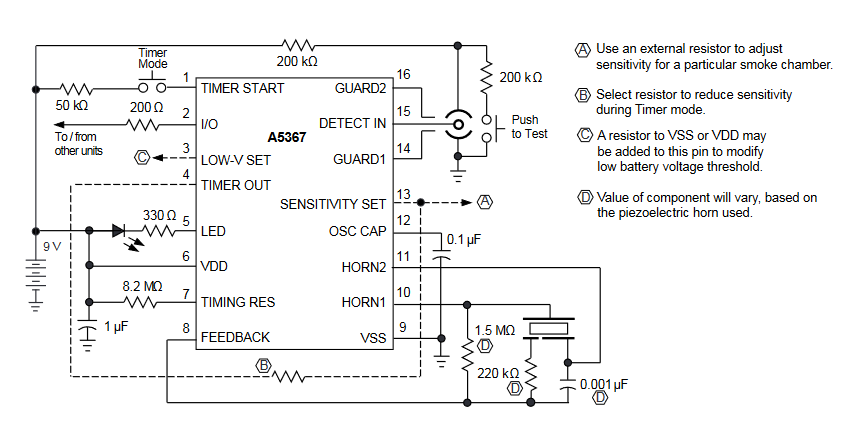
It includes a piezoelectric horn driver, electrical “guard” outputs for the detector input (an analog-circuit technique), pulse testing for low battery, power-on reset (POR), internal reverse-battery protection, timer (hush) mode for enabling a reduced-sensitivity period, and built-in hysteresis to reduce false triggering. The internal oscillator and timing circuitry keep standby power to a minimum by powering down the device for 1.66 seconds and sensing for smoke for only ten milliseconds (Figure 6). Every 24 on-off cycles, a check is made for a low-battery condition.
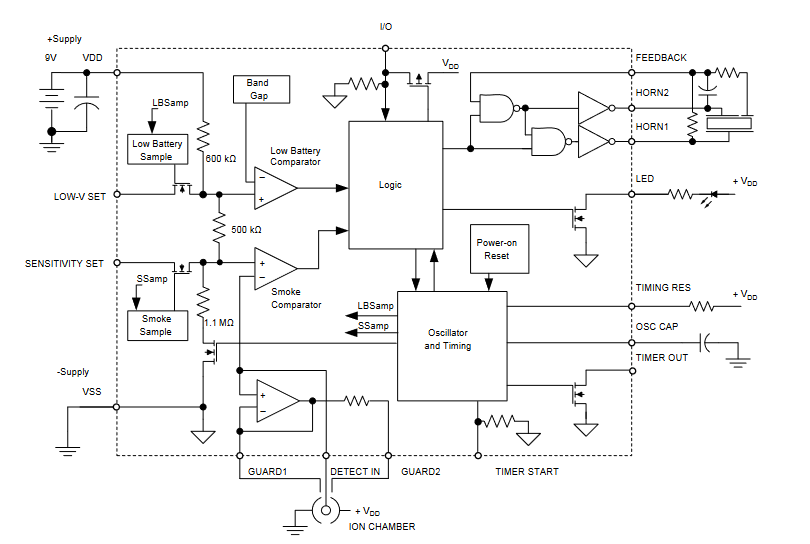
Q: How are smoke detectors powered?
A: As seen above, many smoke detectors use a standard 9-V battery, which is very popular due to its low cost. However, this type also has a drawback—the battery must be replaced every year or two, and so is falling out of favor. Other designs use a long-life lithium battery rated for at least ten years of operation but cannot be replaced; the entire detector is “thrown out” after the battery is depleted.
The rationale here is that this is safer than having useless detectors, which are dead batteries, although it may be considered environmentally wasteful. Some municipalities, such as New York City, have, in fact, mandated that only the 10-year rated units are allowed in new construction or as replacement units. Smoke alarms are also available in 120-V versions, and many local or state building codes require these smoke alarms but with a battery back-up in case of power outages, especially in new construction.
Of course, a real smoke alarm is much more than just electronics. There’s a simple-looking optical assembly with various subtleties, mechanical issues related to a low-cost yet rugged overall design for the mass market, self-test, audio output level, visible LED indicator for the user, and meeting various regulatory mandates.
Q: How does a designer evaluate and fine-tune the smoke alarm IC and circuit?
A: Most vendors offer evaluation or demonstration (demo) boards with test points. For example, the Microchip Technology ADM00344 is a complete stand-alone smoke detector application board with a smoke chamber emulator for their RE46C190 Low-Voltage Programmable, Photoelectric Smoke Detector ASIC (Figure 7).
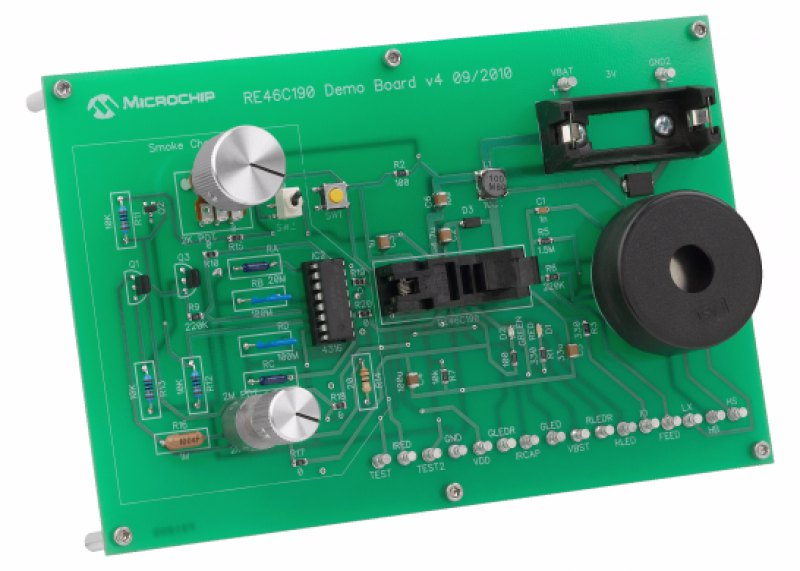
It supports evaluation of all the functions of the RE46C190, with key test points of the device available on the board. The RE46C190 application circuit is on the right side of the board by the battery holder and piezo horn, while the smoke-chamber emulator is on the left. The emulator can be disconnected from the application circuit, and the actual smoke chamber or its components can be connected to the demo board for that final design evaluation phase. The demo board also supports designer adjustment of settings for smoke density, low-battery testing, and other features.
The final section looks at some trends and advanced smoke detectors and alarms.
Related EE World content
Smoke detector reference design and algorithm is UL217-tested and verified
SmokeBot – A Robot Serving Rescue Units
AI/ML-based sensor fusion technology platform targets home-security alarm system
Ultra-low-current detect switches optimized for battery-powered devices
Wireless comm ICs cover UHF, ISM bands for smart meter, gas/fire alarm, security system apps
Free-space optical links, Part 1: Principles
Free-space optical links, Part 2: Technical issues
Free-space optical links, Part 3: Standard units
Additional References
General Resources
- National Fire Protection Association “Smoke Alarms in US Home Fires”
- The Zebra, “House Fire Statistics in 2022”
- NIST, “How Do Smoke Detectors Work?
- S. Fire Administration, “USFA position on home smoke alarms”
- National Fire Protection Association, “Ionization vs photoelectric”
- Wikipedia, “Smoke detector”
- Statistica, “Total number of reported home structure fires in the United States from 1977 to 2020”
- IFSEC Global, “Smoke Detectors Explained”
- IFSEC Global, “The science behind optical beam detection in large, open spaces”
- IFSEC Global, “FFE launches auto-aligning smoke beam detector”
Integrated Circuits – Vendor web sites
- Analog Devices, “Smoke Detection”
- Allegro Microsystems, “Smoke Detector Interface ICs”
- Microchip Technology, “Smoke Detector, CO Detector and Horn Driver ICs”
- NXP/Freescale, “MC145010 Photoelectric Smoke Detector IC with I/O”
- Renesas, “RAA239101 Photoelectric Smoke Detector AFE IC”
- Texas Instruments, “Smoke & heat detector Products and reference designs


